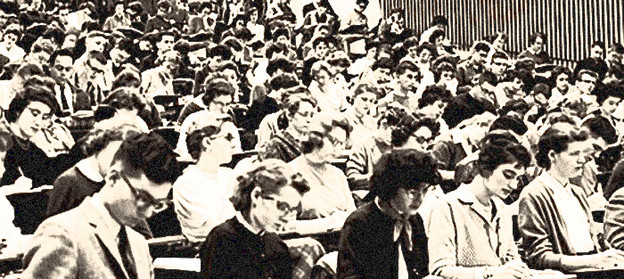Needless iconoclasm
Notes on an anthology of contemporary American poets in 1957

Ray B. West, editor of The Western Review (published for years out of the University of Iowa), went on a rare leave of absence and left things to an acting editor, Richard Freedman. (Paul Engle, faculty director of the Iowa Writers’ Workshop, served as the magazine’s advisory editor.) While Freedman was minding the editorial store, the magazine published as its Spring 1957 issue a selection of twenty-one poets who had come of age in the late 1940s and early 1950s – “essentially,” Freedman noted, “the generation which has developed since the Second World War.” Richard Stern chose the poets and poems. Since the poets of the politicized 1930s were the “teachers and models” of these younger poets and since the 1950s were a very different time, Stern argued, they clearly required “a definition of their own” — an identity not entailing our ideas about the writerly life of the Depression (nor, indeed, of wartime). So what sort of definition would Freedman and Stern offer?
“Widespread acceptance of academic status.” So notes Freedman’s preface to the special issue. His observations were to sketch out “Contours of a Future Sensibility.” The poet’s “battle for survival” having been won, the academy was its new home. If Rimbaud had upbraided his teacher for retreating to the “academic stable,” now such a rebuke, of one poet to his elder, “seems like needless iconoclasm.” Although “cultural and intellectual changes” had occurred in recent years — quite a euphemism for a decade of economic privation and then a total world war that left tens of millions dead and millions displaced, followed by intense Cold War — poetry would now respond, from within its uniconoclastic shelter, “fresh meanings and forms.”
Fresh forms. And yet Stern, in his own preface to the selection — not unambitiously titled “American Poetry of the Fifties” — conceded right off that the poets he’s gathered “will not open up the new measures of a renaissance,” even though a great many contemporary poets — nonacademic poets who nonetheless perfectly befit his criteria of a “generation…developed since the Second World War” — were just then, in 1956 and 1957, making the need of such a renaissance available as a loud claim.
Here are the American poets of the 1950s, decided upon, presumably, on the basis of the aforementioned rubric: William Belvin, Edgar Bowers, Paul Carroll, Donald Finkel, Isabella Gardner, Donald Justice, Galway Kinnell, William H. Matchett, James Merrill, W.S. Merwin, Robert Pack, Donald Petersen, Helen Pinkerton, Adrienne Rich, Louis Simpson, W.D. Snodgrass, William Stafford, May Swenson, Wesley Trimpi, John Woods, and James Wright. Just one of these poets — Paul Carroll — could be said to have any real association with contemporary poets who shared Rimbaud’s sense of his poet-teacher’s academic move or, to put it another way, only one who would have readily rejected the notion that such skepticism was now “needless iconoclasm.”
“Needless iconoclasm” and yet needed “fresh meanings and forms.”
This is classic late-50s-style anti-experimentalist circularity and logical insularity, as I've come to know it from my reading and archival research. Very roughly it runs as follows: Stern chooses 21 young poets he admires, claiming modestly that no poetic renaissance has been incurred; Freedman, as editor of a magazine ensconsed at Iowa, frames it editorially by noting the "fact" the “widespread acceptance of academic status” among poets, as judged by the selection Stern had made — and not obviously judged on the basis of those poets excluded, among them, first, poets descended directly from the 1930s, and, second, already emergent poets associated with any of the many groups soon to be known as the “New American.”
The poets here helped render iconoclasm needless. And they could be generalized as having “a solid command of technique” (Freedman). Their manner of “hav[ing] learned from the tradition of their language” enabled them, when grouped together, to “etch the outlines of a future sensibility.” So much for the young poets of the time finding a “definition of their own.”